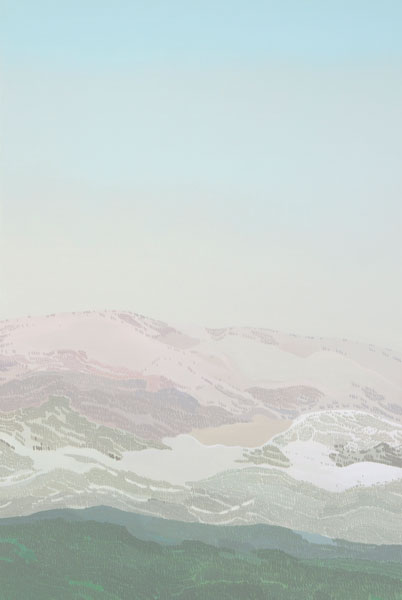
April 1, 2015
Jake Longstreth: Free Range at Gregory Lind Gallery

Jake Longstreth. Free Range, 2014; oil on canvas in artist frame; 60 x 40 in.
For urban dwellers with the means and motivation to leave the city in search of open space, there is a crucial moment when the last big-box store fades in the rear-view mirror and the mountains loom ahead. LA-based artist Jake Longstreth’s humble paintings featured in Free Range at Gregory Lind Gallery present the viewer with a likewise ambivalent moment when the promise of freedom becomes tinged with a nagging, indefinite apprehension.
Longstreth’s landscape paintings depict distant mountain ranges under vast skies, but they deal not so much with nature as with the concept of the sublime. A low-grade, unspoken dread is present in all nine of his paintings, which range in scale from intimate to body-sized. It is crucial to understand that the artist elected to paint from memory, which gives his imagination free rein—yet the works are restrained in composition, facture, and palette. It is precisely the use of an understated palette, especially in the skies where greenish grays and hazy pinks blend to dead blues in seamless gradations, that gives viewers the creeping sense that we are not experiencing the respite from the city that was promised. Rather, we experience nature’s inability to reveal anything to us other than what we project onto it.
Another way that Longstreth evokes the sublime is through his use of light. It recalls the work of 19th-century American Luminist painters such as Fitz Hugh Lane and Martin Johnson Heade. As Barbara Novak puts it: “In the smaller luminist paintings … light, because of its silent, unstirring energy, causes the universe, as Emerson would have it, to become ‘transparent, and the light of higher laws than its own’ to shine through it.”[1] The light in Longstreth’s work, however, is subtly filtered through smog, dust, and wildfire smoke; it allows the viewers, in a surprisingly non-prescriptive way, to come to terms with the universe we’ve created, one whose “higher laws” are really just the consequences of our own actions.
Longstreth’s paintings successfully provide a moment of honest contemplation. It’s a silent moment, when one’s internal drama can coalesce with the knowledge of inescapable change—rising temperatures, mega-drought, year-round wildfire seasons, and diminishing air quality. We know all of these things to be true, yet we are compelled to drive out to the mountains, over and over again.
[1] Barbara Novak, Nature and Culture: American Landscape and Painting, 1825–1875 (New York: Oxford University Press), 43.